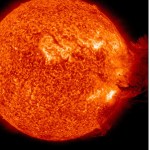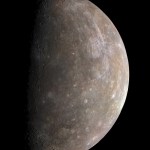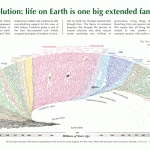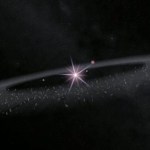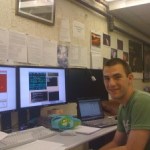asteroids
For once an asteroid strikes when we were kinda, sorta expecting one to. According to the Washington Post, the Russian Academy of Sciences "estimated that the meteor weighed around 10 tons and was traveling at 10 to 12 miles per second (roughly 30,000 to 45,000 mph) when it disintegrated." The same report estimates that more than 1,200 people were injured by the blast in the Russian city of Chelyabinsk, 900 miles east of Moscow. Based on video of the event, on Dynamics of Cats, Steinn Sigurðsson says it "looks like a fairly slow shallow angle impact, detonating with kiloton…
On February 15th, Asteroid 2012 DA14 came hurtling between us and our satellites, twelve times nearer than the Moon, so close that it was visible through binoculars from certain parts of the globe. Greg Laden writes, "This asteroid is not going to hit the earth now or during any of the next few decades, but eventually it may well do so." On Starts With a Bang, Ethan Siegel writes that the Sun's 11-year Solar Cycle peaks in 2013, meaning we can look forward to a year filled with solar flares. Even when these are spewed towards Earth, our magnetic field protects us from irradiation. But solar…
"You don't drown by falling in the water; you drown by staying there." -Edwin Louis Cole
Our Solar System is -- at least from our perspective -- the most well-studied system of planets, moons, asteroids and comets in the entire Universe.
Image credit: Olaf Frohn, from earlier in 2012.
And in this system, the closest planet to our Sun, Mercury, was also one of the most poorly understood planets until very recently. Because Mercury is so close to the Sun, it's very difficult to view it under good conditions with a telescope; the risk of ruining your optics by exposing them to direct…
New research rethinks the possible prevalence of life in the Universe, suggesting that our asteroid belt—as disrupted by the gravitational influence of Jupiter—played a key role in seeding the Earth with water and organic compounds. Unable to coalesce, and situated around the solar system's "snow line," the belt provides millions of little ice trays which come smashing into the Earth on occasion. On Starts With a Bang, Ethan Siegel says "getting struck by asteroids can introduce new organics and materials into the ecosystem, and can knock off the apex animals of the time, paving the way for…
"The important point is that since the origin of life belongs in the category of at least once phenomena, time is on its side. However improbable we regard this event, or any of the steps which it involves, given enough time it will almost certainly happen at-least-once. And for life as we know it, with its capacity for growth and reproduction, once may be enough." -George Wald
That there's an amazing story of life's evolution on Earth is a scientific certainty. The evidence is encoded in the nucleic acid sequences of every living organism ever discovered, and the history of life on this…
"I have announced this star as a comet, but since it is not accompanied by any nebulosity and, further, since its movement is so slow and rather uniform, it has occurred to me several times that it might be something better than a comet. But I have been careful not to advance this supposition to the public." -Giuseppe Piazzi, discoverer of Ceres, the first Asteroid
Out beyond Mars, but not quite out as far as Jupiter, a collection of thousands of rocky objects, ranging in size from pebbles all the way up to the size of Texas, lies the asteroid belt.
Image credit: David Minton and Renu…
By Dr. Franck Marchis
Planetary Astronomer at the Carl Sagan Center for the Study of Life in the Universe, SETI Institute
I mentioned in my previous post that we observed several known multiple asteroid systems during our last observing run with the W.M. Keck Observatory and its Adaptive Optics Systems. If you have been following my personal blogs and/or the scientific articles of our group (you are courageous...) you know this is the scientific topic which is taking most of my time recently. Today, as you can see if you explore our VOBAD database, we know 192 companions of asteroids. What I…
By Dr. Franck Marchis
Planetary Astronomer at the Carl Sagan Center for the Study of Life in the Universe, SETI Institute
I'd like to share the first of two blogs on observations of Io that we did using the Keck telescope and its Adaptive Optics (AO) system.
Similar to last year, my summer is busy with the REU (Research Experience for Undergraduates) students of the SETI Institute. I will write a specific post on two students who are working with me and their project in a few days.
I obtained telescope time at the end of June 2010 with the W.M. Keck II telescope and its Adaptive Optics system…
